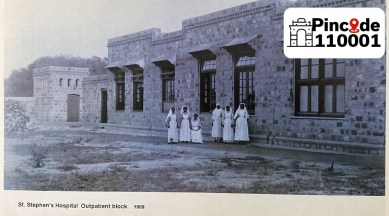Stay updated with the latest - Click here to follow us on Instagram
Pincode 110001: Humble beginnings of Delhi’s St Stephen’s hospital — from Yamuna riverbank to Tis Hazari
Now located near Tis Hazari court, the super-speciality tertiary care hospital has over 600 beds and caters to around 16,000 patients every year.

From a small hut on the banks of the Yamuna to a house in Chandni Chowk — St Stephen’s Hospital, Delhi’s first medical facility for women and children, had a humble beginning over a century ago. Behind its establishment were efforts by a group of women, led by Priscilla Winter, who understood the healthcare needs of women and children.
Now located near Tis Hazari court, the super-speciality tertiary care hospital has over 600 beds and caters to around 16,000 patients every year. It is managed by the St Stephen’s Hospital Society, a constituent part of the Church of North India, and is a registered body (under the Societies Registration Act) functioning under its own constitution.
monthly limit of free stories.
with an Express account.
Born in Calcutta in 1842, Priscilla was the daughter of parents who were part of the Church Missionary Society (CMS). After studying in England, she returned to Calcutta in 1858 at the age of 16. She started the Delhi Female Medical Mission, along with the White Ladies Association, and worked in the ‘zenana’ mission, which was the work of education and care of women in their homes.
In the 1860s, she began providing medical care to people in a small hut on the banks of the Yamuna with a box of medicines and simple remedies.
After her marriage to Robert Winter, the head of the Society for Propagation of the Gospel Mission in Delhi, Priscilla began ‘zenana’ visiting and trained a number of women for it in 1863. She then called for the help of others through the White Ladies Association to run a small dispensary in the city.
In 1870, the women rented a room in Chandni Chowk and patients were attended to by a nurse/midwife. With the patient load increasing, they took a house for rent in the same area next year. Equipped with a dispensary and 10 beds, it employed female staff till 1874 when one Dr Bose joined. According to officials at the hospital, he gave valuable advice as there was no other doctor and not even a trained nurse at that time, but died the following year.
Dr Sudhir C Joseph, director of the institute, said there isn’t much information available on Dr Bose: “We are finding out more about who he was. On the hospital’s 125th anniversary, when we were compiling its history from various books, we found his name mentioned in one of the books written on the early history of the hospital.”
By 1876, 18 local women were enrolled in a nursing class, which was a two-year course of instruction examined half-yearly by the Government Civil Surgeon. At that time, the Punjab Government was giving Rs 410 a year for medicines and the Delhi Municipality was contributing Rs 75 a month in scholarships for training women as nurses.
In 1881, Priscilla died at the age of 39. In her memory, a plot of land in Chandni Chowk was bought by the hospital administration on which a small 50-bed hospital was built overlooking Queen’s Gardens, now known as Company Bagh. It was named St Stephen’s Hospital and inaugurated by Lady Dufferin, the wife of the then Viceroy of India.
By this time, the hospital was getting extremely crowded. During Dr Jenny Muller’s tenure, who was also the first full-time doctor in the hospital till 1916, it acquired the land where the current building stands. Muller was a young woman of Indian-German origin and had joined the Mission as a teacher-evangelist in 1884.
On December 3, 1906, the foundation stone of the building was laid at Tis Hazari, overlooking what was then a Police Parade Ground and now the Tis Hazari Courts. The hospital was formally opened on January 9, 1909, while the OPD had been opened six months earlier.
Today, this building has the Nursing College and a part of it has the Physical and Medical Rehabilitation Centre. The years to come witnessed the construction of several departments and development of various facilities.
After Independence, Dr Lucy Oommen became the first Indian to take charge in 1961 as the hospital’s medical superintendent. Dr Oommen was also awarded the Padma Shri in recognition of her service to the hospital and to the community. According to hospital officials, she remains the longest-serving doctor in the history of St Stephen’s Hospital, having worked for over four decades.